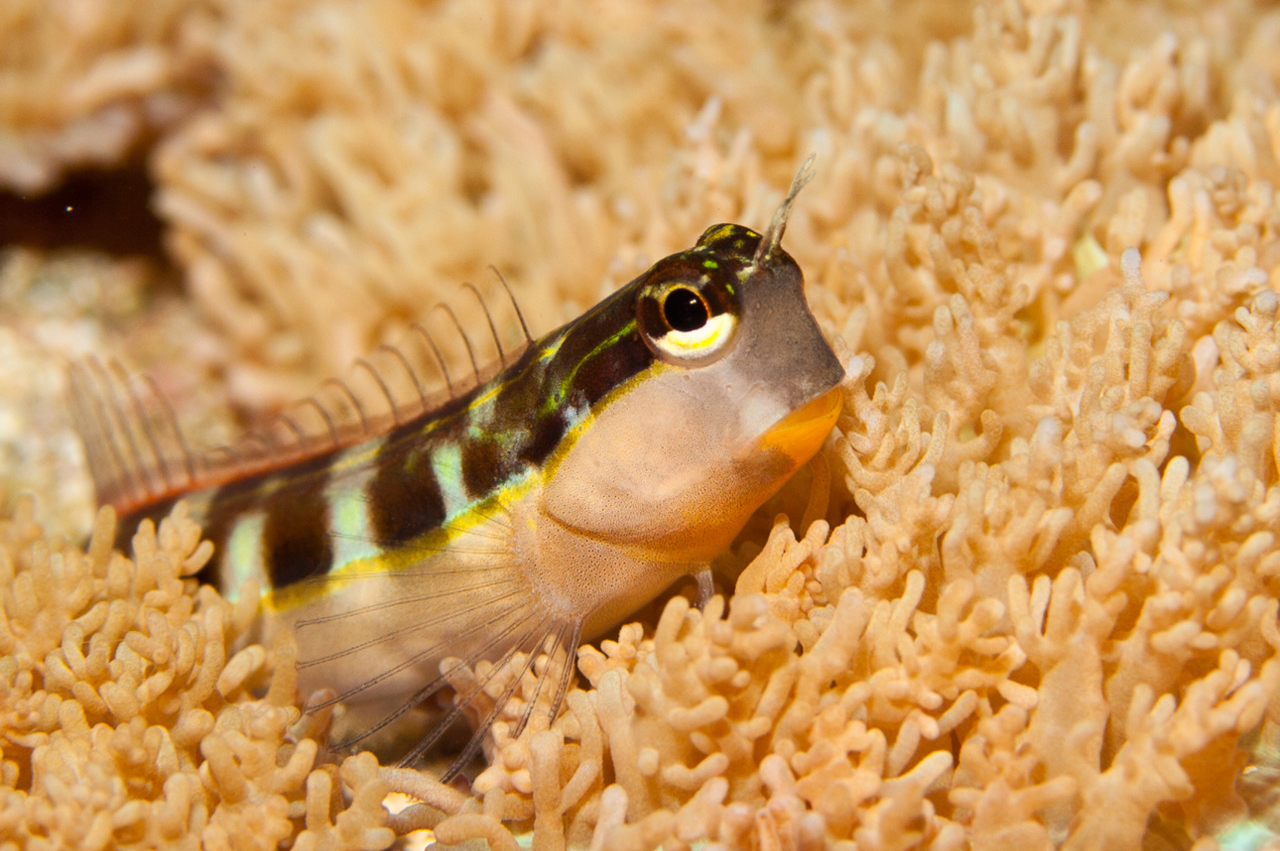Lined Combtooth Blenny, Ecsenius lineatus Klausewitz 1962
Other Names: Linear Blenny, Lined Blenny, Lined Comb-tooth, Lined Combtooth-blenny, Lined Coralblenny

A Lined Combtooth Blenny, Ecsenius lineatus, at Hyotan Island, Ogasawara, Japan - depth 12 m. Source: orangkucing / http://orangkucing.tumblr.com/. License: CC BY Attribution-ShareAlike
Summary:
A combtooth blenny with two dark lateral stripes, one immediately above the pectoral fin and one from the chin running below the eye through the pectoral-fin base, usually separated by a yellow stripe (sometimes a white stripe). The species also has a narrow dark stripe along the dorsal-fin base, a black submarginal band on the dorsal fin, and a yellow caudal fin.
The dark stripe running through the eye is separated from the margin of the upper lip by a broad pale area that is about equal to, or wider than the width of the dark stripe.
The dark stripe running through the eye is separated from the margin of the upper lip by a broad pale area that is about equal to, or wider than the width of the dark stripe.
Cite this page as:
Bray, D.J. 2021, Ecsenius lineatus in Fishes of Australia, accessed 06 Jul 2025, https://fishesofaustralia.net.au/home/species/1062
Lined Combtooth Blenny, Ecsenius lineatus Klausewitz 1962
More Info
|
Distribution |
North West Cape, Western Australia, to Ashmore Reef in the Timor Sea. Elsewhere, the species is widespread in the tropical, east-Indo-west Pacific. Inhabits clear shallow coastal reef patches and offshore reef crests, usually at depths above 5 m. |
|
Features |
Dorsal fin XII-XIII, 16-18; anal fin II, 18-20; Pectoral fin 12-14; Pelvic fin I, 3. Long cirrus only on posterior margin of anterior nostril; last lateral-line tube below 9th-11th dorsal-fin spine. |
|
Etymology |
The specific name is from the Latin lineatus (= lined, striped), in reference to the broad, black longitudinal band along the sides. |
|
Species Citation |
Ecsenius lineatus Klausewitz, 1962, Senckenberg. Biol. 43(2): 145. Type localty: Reef in lagoon near Madewaru Island, Fadiffulu Atoll, Maldives. |
|
Author |
Bray, D.J. 2021 |
|
Resources |
Lined Combtooth Blenny, Ecsenius lineatus Klausewitz 1962
References
Allen, G.R. 1997. Marine Fishes of Tropical Australia and South-east Asia. Perth : Western Australian Museum 292 pp. 106 pls.
Allen, G.R. & Erdmann, M.V. 2012. Reef fishes of the East Indies. Perth : Tropical Reef Research 3 vols, 1260 pp.
Allen, G.R. & Swainston, R. 1988. The Marine Fishes of North-Western Australia. A field guide for anglers and divers. Perth, WA : Western Australian Museum vi 201 pp., 70 pls.
Klausewitz, W. 1962. Escenius lineatus n. sp. von den Malediven (Pisces, Blenniidae). Senckenbergiana Biologica 43(2): 145-147.
Kuiter, R.H. 1992. Tropical Reef-Fishes of the Western Pacific, Indonesia and Adjacent Waters. Jakarta : PT Gramedia Pustaka Utama 314 pp. pls.
Kuiter, R.H. & Tonozuka, T. 2001. Pictorial guide to Indonesian reef fishes. Part 2. Fusiliers - Dragonets, Caesionidae - Callionymidae. Australia : Zoonetics pp. 304-622.
Springer, V.G. 1971. Revision of the fish genus Ecsenius (Blenniidae, Blenniinae, Salariini). Smithsonian Contributions to Zoology 72: 1-74 figs 1-36 https://doi.org/10.5479/si.00810282.72
Springer, V.G. 1988. The Indo-Pacific Blenniid fish genus Ecsenius. Smithsonian Contributions to Zoology 465: 1-134 figs 1-68 pls 1-14 https://doi.org/10.5479/si.00810282.465
Springer, V.G. & Allen, G.R. 2004. Ecsenius caeruliventris and E. shirleyae, two new species of blenniid fishes from Indonesia, and new distribution records for other species of Ecsenius. Zootaxa 791: 1-12 https://doi.org/10.11646/zootaxa.791.1.1
Watson, W. 2009. Larval development in blennies. pp. 309-350. In Patzner, R.A., E.J. Gonçalves, P.A. Hastings & B.G. Kapoor (eds) The biology of blennies. Science Publishers, Enfield, NH, USA. 482 pp.
Williams, J.T. 2014. Ecsenius lineatus. The IUCN Red List of Threatened Species 2014: e.T48342329A48346892. https://dx.doi.org/10.2305/IUCN.UK.2014-3.RLTS.T48342329A48346892.en. Downloaded on 06 August 2021.





